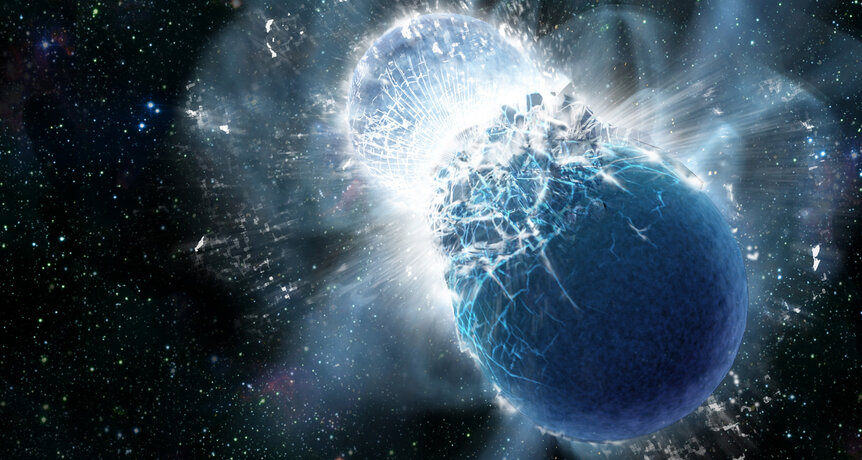Create a free profile to get unlimited access to exclusive videos, sweepstakes, and more!
The birth of a little black hole may have revealed a much bigger black hole

The birth cry of a distant black hole may have revealed the existence of a closer, much more massive black hole, part of a population of these beasts that is proving devilishly difficult to find.
There are three general classes of black holes we know of. One is created when a massive star explodes, or two superdense neutron stars collide. These tend to have between roughly 5 and 50 times the mass of the Sun, so we call them stellar-mass black holes.
Supermassive black holes are the second kind, found in the centers of galaxies, and have millions or billions of times the mass of the Sun (like the one in M87, famously imaged in recent observations).
There should be a population in between these two, called intermediate mass black holes (or IMBHs). These have from several hundred up to several hundred thousand times the Sun's mass. There's plenty of evidence they exist — for example observations of dwarf galaxies indicate some have ones on the biggish end of the scale, and others appear to be the culprit behind tidal disruption events, when a black hole literally tears a star to shreds and eats it — but definitive proof has been hard to pin down.
An interesting way to look for them is through gravitational lensing. If the light from a distant object passes a massive object (called the lens; generally speaking it's a cluster of galaxies but a black hole will do the trick, too) on its way to Earth, the mass warps the space the light is traveling through, changing its behavior. In images we can see rings, arcs, and blobs surrounding the distant source, all mirages caused by the massive lens.
Another lensing effect can be seen if the light is from a transient, an event that is short lived, like an explosion. The light is emitted in all directions from the event, some of which is sent straight to us. But if there's a lensing mass off to the side a bit somewhere between us and the explosion, its gravity warps the path, bending a bit of the light toward us that otherwise might have missed. It has to take a longer path to get to us, so we see the same explosion a second time, delayed by some amount.
In the new work, scientists looked at gamma-ray bursts, staggeringly immense explosions that occur when stellar-mass black holes are born. These can be short (lasting about 2 seconds, generally from when neutron stars merge) or long (greater than 2 seconds and up to several minutes, when a massive star explodes and its core collapses to form the black hole).
The Burst and Transient Source Experiment (or BATSE) was a gamma-ray detector on board the Compton Gamma Ray Observatory, which orbited Earth from 1991 to 2000. Over its lifetime BATSE saw 2,700 gamma-ray bursts, a huge number, about one per day. The scientists combed through them all, looking for any that seemed to repeat after a delay.
Out of them all, they found one: GRB 950830, a burst from August 30, 1995. It was a short burst with a pulse of gamma rays that lasted about 0.2 seconds. However, 0.4 seconds later a second pulse was seen. It was detected in four different energy channels (similar to colors in visible light); and while the shape of the pulse was different in the four channels as expected, in every channel the second pulse had nearly the exact same shape as the first pulse seen.
That sounds very much indeed like a gravitational lens, like an echo of the actual burst. Looking at it statistically they find a greater than 99% chance this is not a false alarm; that is, it's a real gravitational lensing event.
The delay in the arrival of the second pulse can be used to get the mass of the lensing black hole. This is actually pretty complicated and depends on the geometry of the event (how far to the side of the line between us and the burst the black hole is) and the distance to both the black hole and the lensed burst. But they find the black hole has a maximum mass of 55,000 times the mass of the Sun. If it's farther away it's less massive, but it's essentially impossible for it to be so far away the mass drops into the stellar-mass range.
In other words, this looks very much like an intermediate mass black hole.
Given how rare this event was (only one seen in 2,700 bursts) they estimate there are roughly 65 of these IMBHs per million cubic light years of space. I know that's a difficult unit to grok, but another way to say this is they think there should be very roughly 40,000 such IMBHs within about 5 million light years of the Milky Way (so that includes a handful of galaxies in our neighborhood).
Not bad. Maybe we'll find more soon. They estimate a 50% chance another such lensed burst may exist in other observatory databases, so perhaps a second will be found.
We think that IMBHs could act as the seeds for supermassive black holes; in the early Universe the intermediate mass ones could have formed first, then collided with each other or eaten material to grow rapidly. This is still one of the biggest outstanding issues in cosmology, so understanding the role of IMBHs is critical.
But first we need to definitively find them, and in such a way that we can study them using various methods. I suspect we are very close to doing just that.




























